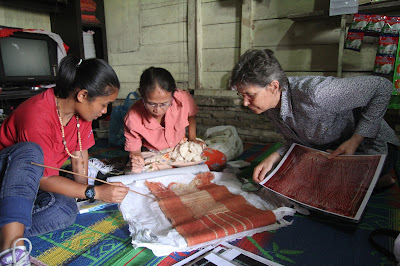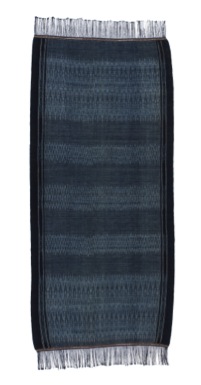 |
| Ma Tika at work in her loom |
During my last journey to Indonesia, I met Lasma's weaving teacher, Ma Tika, Nesli br. Saragih, a Simalungun woman. I invited her to travel with us as we
were at the beginning of a journey that would take us to various weavers in
different Batak regions. She had other plans, but she cancelled them and seized this new opportunity with both hands. She was quiet and modest in the extreme (a bit intimidated),
but as the days went by, I got to know her a little bit. I loved watching her single-mindedly
take every single opportunity that presented itself to expand her weaving
knowledge and skill. For her the journey must have been a once-in-a-lifetime
chance. For me it was an
affirmation of how important it is for weavers to have a network that inspires
and teaches them. If that network was once available in a weaver's village, now a weaver has to
travel far and wide to construct it. Such is the consequence of the decline and
disappearance of the weaving tradition.
Ma Tika (the mother of Tika; in the Batak area you reference
people by the names of their children or grandchildren if they have them)
started to weave at the turn of this 21st century. She is now 48 years old, so
she must have been around 30 years old when she began. She had watched her mother weave the bulang as
a child and did the things that children do, like winding the weft. Her weaving
spirit expressed itself very early; she longed to work in the loom rather than
in the fields and so at one point she insisted on learning to weave. For various reasons her mother refused to teach her; undaunted, she taught herself. This is
remarkable. She had watched her mother weave, and she had an example of the
bulang in her possession. She simply went to work by trial and error learning
how to replicate the textile in her possession. She explained that this important
textile -- afterall, it is worn on the
head !!! -- cannot have flaws. As she struggled to learn she unravelled her
work every time she made an error. Wove and un-wove, wove and un-wove. This is the most difficult textile in the Siimalungun repertory! When I
met her, she showed me her work and asked me to critique it. I didn't
understand the significance of her request at first as I thought: you are a
weaver, you know better than I how to weave!
 |
Weaving supplementary weft is all about counting the warp yarns to
make the correct shed |
Gradually, however, I came to understand what she wanted from me. She needs colleagues and also technical insights into how
to produce a high quality textile. She learned to weave when the marketplace
was already enforcing shortcuts on the weavers, demanding that they weave more loosely to use
less yarn and more quickly in order to have another cloth ready for the next
market. She never learned in the 'traditional way' that emphasized quality. When she was learning, meeting the parameters of the market
meant being able to eat, so she learned how to make a textile fast, using
shortcuts. Since those days, the bottom has fallen out of even that very poor market because mechanized producers have
started to make a version of the bulang -- certainly a version of lower quality, but also a cheaper
version that the market has welcomed. Almost every backstrap weaver was
forced by these new circumstances to stop weaving the bulang. Ma Tika
has been able to continue because she obtains orders from the Church where
there are some people willing to pay the higher price. Ma Tika does not know
how much one of her textiles fetches; she only knows how much she is paid for
her labour. One cannot claim that it is a living wage, far from it; the amount
she earns is painfully, heart-stoppingly low. But Ma Tika continues to weave.
She is a weaver at heart, not a gardener. She loves the bulang.
She knew from Lasma that I had
an old bulang textile in my possession and she begged me to bring it to show to her. I did this and her
reaction was remarkable. She pulled out a needle-like instrument and
immediately started counting the yarns in the supplementary weft section.
Her own textiles are loosely woven; she wanted
to know how to make a more densely woven cloth and the impact that would have
on the patterning. By examining the old cloth, she obtained her answer.
 |
Ma Tika, Lasma and I examining the old bulang.
In my hand is a blown-up, laminated image of a pattern in one of
Pamela's bulang textiles
(Photo by MJA Nashir) |
From my friend,
Pamela Cross, a bulang aficionado, I had
received detailed photographs of several bulang end fields (where the
supplementary weft is located). I printed them larger than life, laminated
them, and gave them to Ma Tika to refer to. She latched onto them with the same
alacrity and started to count yarns. Her findings yielded all kind of insights
about different time periods, availability of various kinds of yarn, the ways
of working of weavers in the past and variety in patterning.
I was able to contribute from my knowledge of museum
collections and Batak textile history. I pointed out that machine-like
perfection is not a characteristic of the textiles made long ago, that there is
in fact charm in the hand of the weaver and in the imperfections. I told her
that each region once had its own specialty expressed through technique, design
and colour, that different yarns have come onto the market at different times,
that the tradition is dynamic and has never been stable, that there is also
room for her to experiment and build on the past. All of these were new
insights to her. She works in a time when a single template is replicated and
the standard of weaving has become extremely narrow. Initially Ma Tika was
inclined to judge the textile that was closest to what is made today as the
"correct" textile. Exploring the images and discussing them gave
birth to a new goal for her. Now she wants to replicate the one that is most
'foreign' to her and thus represents the greatest challenge. In fact, she is up
for replicating them all. I reminded her that she also has a creative spirit
that could express itself in the cloth.
 |
Comparing the old with the new in Ma Tika's home
(Photo by MJA Nashir) |
As our journey proceeded, we met Batak women who plant
cotton. Ma Tika collected cotton seeds. We met a natural dyer. There, Ma Tika
collected the seeds for the indigo plant and the bark of the roots of the
morinda citrifolia that yields red dye. She also collected the recipes for the
dyes. In addition, we ordered enough yarn to be dyed with these colours that
she will be able to make many bulang with natural dyes even while she is
learning the dye technique herself.
We met twiners, the specialists who make the patterned edgings in Batak textiles. Ma Tika watched their work and learned the technique but
decided that she would rather stay with her own regional specialty for her
bulang textile.
She saw weft holders used in the Toba Batak region and
brought one home to Simalungun, only to discover that it did not function properly
for her because her weft is wound differently. She learned that her region was
not 'lacking' in a weft holder, but that even the way weft is wound is a
regional specialty in its own right.
Ma Tika has been using a loom passed down from her mother.
She claims that it is too small for her. During the journey she met a weaver
who was willing to pass on parts of the loom that she needed to be able to make
a wider textile.
And our sponsor, Bank Indonesia, agreed to purchase a new
pair of glasses for her so that she can see better as she weaves.
All in all, our journey may well have supplied Ma Tika with
all of her basic needs to be able to revive a bulang textile of former glory: sumptuous, beautiful, densely woven.
I love to work with self-motivated, enthusiastic weavers. In
fact, I say over and over again that there is no point trying to work with a
weaver who does not have these characteristics. Ma Tika's road to the future
will not be an easy one. She will only be able to conduct her experiments in
her 'free time' and she has little of that because she weaves for a living and
earns so desperately little. She is a widow and still has dependent children. Moreover,
she only has one loom and can't have two textiles on the go at one time. But
she has will and determination. She learned to weave by herself, she loves the
bulang tradition, and she loves a challenge. She is clever, strong and
determined. She will give it her best shot -- and she will share her work with
Lasma every step of the way. If a bulang revival happens in Simalungun, it will
be due to her. May she remain healthy and spared from disasters!
Towards the end of our journey we visited the T.B. Silalahi
museum in Balige. Ma Tika was disappointed with the Simalungun textiles she saw there on display. Now she has an additional goal: to make a textile that will one day
be displayed in the museum and become a source of pride for all Simalungun
visitors.
Go Ma Tika, go!


